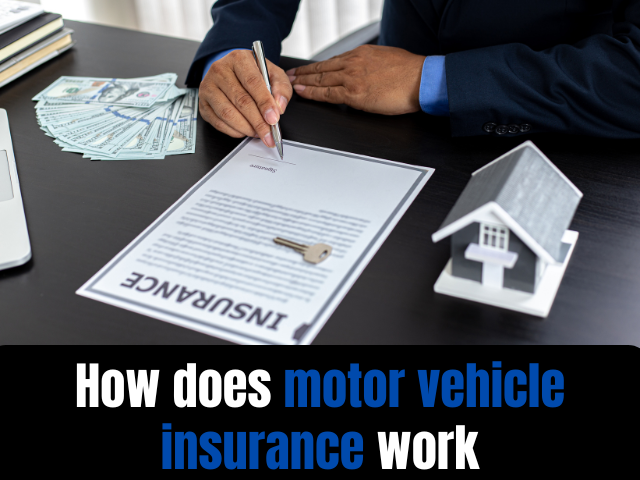Motor vehicle insurance is an essential aspect of responsible car ownership. Whether you’re a new driver or have been on the road for years, understanding how auto insurance works can help you make informed decisions and protect your financial well-being. In this comprehensive guide, we’ll delve into the ins and outs of motor vehicle insurance, covering everything from basic concepts to advanced tips for getting the best coverage.
What Is Motor Vehicle Insurance?

Motor vehicle insurance, also known as auto insurance or car insurance, is a contract between you and an insurance company. This agreement provides financial protection in case of accidents, theft, or damage to your vehicle. In exchange for paying regular premiums, the insurance company agrees to cover certain costs associated with these events, subject to the terms and conditions of your policy.
Why Is Motor Vehicle Insurance Important?
- Legal requirement: In most countries and states, having some form of auto insurance is mandatory for driving on public roads.
- Financial protection: Insurance helps cover potentially expensive repair or replacement costs in case of accidents or theft.
- Liability coverage: It protects you from financial responsibility if you cause injury or property damage to others while driving.
- Peace of mind: Knowing you’re protected can reduce stress and anxiety associated with driving and potential accidents.
Types of Motor Vehicle Insurance Coverage

Understanding the different types of coverage available is crucial for choosing the right policy. Here are the main types of auto insurance coverage:
1. Liability Insurance
Liability coverage is the foundation of most auto insurance policies. It consists of two main components:
- Bodily injury liability: Covers medical expenses, lost wages, and legal fees if you injure someone in an accident.
- Property damage liability: Pays for damage you cause to another person’s property, such as their car or a fence.
2. Collision Coverage
This type of insurance pays for damage to your own vehicle resulting from a collision with another vehicle or object, regardless of who is at fault.
3. Comprehensive Coverage
Comprehensive insurance protects your vehicle from non-collision-related incidents, such as:
- Theft
- Vandalism
- Fire
- Natural disasters (e.g., floods, hurricanes)
- Falling objects (e.g., tree branches)
4. Personal Injury Protection (PIP)
PIP coverage, also known as “no-fault” insurance, pays for medical expenses and lost wages for you and your passengers, regardless of who caused the accident.
5. Uninsured/Underinsured Motorist Coverage
This type of insurance protects you if you’re involved in an accident with a driver who has insufficient or no insurance coverage.
6. Gap Insurance
Gap insurance covers the difference between your car’s actual cash value and the amount you owe on your auto loan if your vehicle is totaled or stolen.
How Motor Vehicle Insurance Premiums Are Calculated
Insurance companies use various factors to determine your premium. Understanding these factors can help you potentially lower your insurance costs:
- Age and driving experience
- Driving record and claims history
- Type of vehicle (make, model, and year)
- Annual mileage
- Location (urban areas typically have higher rates)
- Credit score (in some regions)
- Occupation and education level
- Marital status
- Coverage types and limits
- Deductible amount
The Claims Process: How It Works
When you need to file a claim, understanding the process can help streamline the experience:
- Report the incident: Contact your insurance company as soon as possible after an accident or incident.
- Provide information: Give details about the incident, including photos, police reports, and witness statements if available.
- Claims adjuster assessment: An adjuster will evaluate the damage and determine the cost of repairs or replacement.
- Coverage determination: The insurance company will review your policy to determine which damages are covered.
- Payment or denial: If approved, the insurance company will pay for covered damages, minus your deductible. If denied, they’ll explain why.
- Repairs or replacement: Depending on the extent of damage, your vehicle will either be repaired or replaced.
READ MORE: Can you get health insurance for dogs?
Tips for Choosing the Right Motor Vehicle Insurance
Selecting the appropriate insurance coverage can be challenging. Here are some tips to help you make an informed decision:
- Assess your needs: Consider your vehicle’s value, your driving habits, and your financial situation when choosing coverage types and limits.
- Compare quotes: Get quotes from multiple insurance providers to find the best rates and coverage options.
- Look for discounts: Many insurers offer discounts for safe driving, multiple policies, or safety features in your vehicle.
- Read the fine print: Understand the terms, conditions, and exclusions of your policy before signing.
- Review and update regularly: Reassess your coverage needs annually or when significant life changes occur.
- Consider bundling: Combining your auto insurance with other policies (e.g., homeowners or renters insurance) can often lead to discounts.
- Maintain a good credit score: In many regions, a higher credit score can result in lower insurance premiums.
- Choose a higher deductible: Opting for a higher deductible can lower your premium, but make sure you can afford to pay it if needed.
READ MORE: How motor insurance premium is calculated
Common Motor Vehicle Insurance Myths Debunked
Let’s address some common misconceptions about auto insurance:
- Myth: Red cars are more expensive to insure.
Truth: Car color doesn’t affect insurance rates. Factors like make, model and safety features are more important. - Myth: Personal auto insurance covers business use of your vehicle.
Truth: Most personal policies don’t cover business use. You may need commercial auto insurance for work-related driving. - Myth: Your insurance covers you when driving someone else’s car.
Truth: Coverage can vary. Check your policy or consult your insurance agent for specifics. - Myth: Insurance follows the car, not the driver.
Truth: This depends on the policy and situation. In some cases, coverage follows the car, while in others, it follows the driver. - Myth: No-fault insurance means you’re never at fault in an accident.
Truth: No-fault insurance refers to how medical expenses are paid, not who’s responsible for the accident.
The Future of Motor Vehicle Insurance
The auto insurance industry is evolving with technological advancements and changing consumer preferences:
- Usage-based insurance: Policies based on actual driving behavior, tracked through telematics devices or smartphone apps.
- Pay-per-mile insurance: Premiums calculated based on the number of miles driven.
- Artificial intelligence in claims processing: AI and machine learning to streamline claims and detect fraud.
- Autonomous vehicle coverage: As self-driving cars become more common, insurance policies will need to adapt to cover new risks.
- Cyber security coverage: Protection against hacking and data breaches in connected vehicles.
- On-demand insurance: Short-term coverage options for temporary needs, such as car-sharing or rental situations.
Motor vehicle insurance is a crucial aspect of responsible car ownership, providing financial protection and peace of mind. By understanding how it works, the types of coverage available, and the factors affecting your premiums, you can make informed decisions about your auto insurance needs.
Remember to regularly review your policy, compare quotes from different providers, and adjust your coverage as your circumstances change. With the right insurance in place, you can hit the road with confidence, knowing you’re protected against unforeseen events.








1 Comment